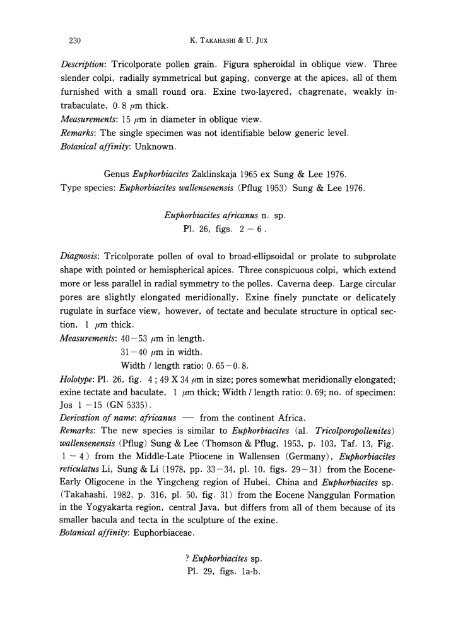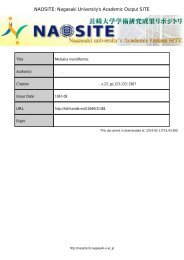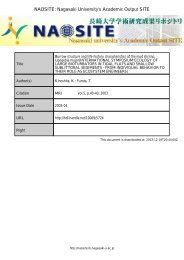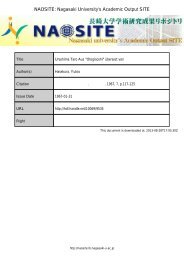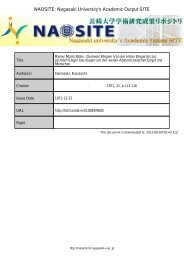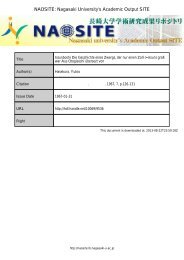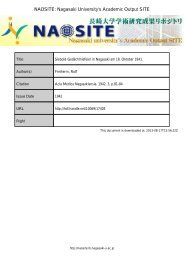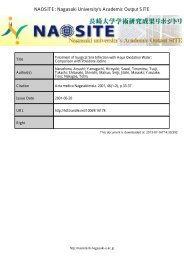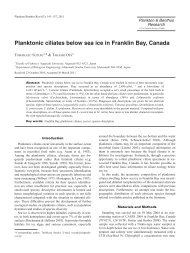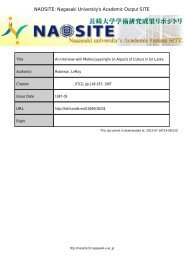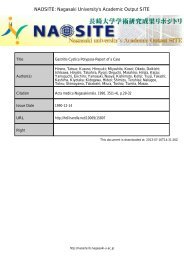Palynology of Middle Tertiary lacustrine deposits
Palynology of Middle Tertiary lacustrine deposits
Palynology of Middle Tertiary lacustrine deposits
You also want an ePaper? Increase the reach of your titles
YUMPU automatically turns print PDFs into web optimized ePapers that Google loves.
230 K. TAKAHASHI & U. lux<br />
Description: Tricolporate pollen grain. Figura spheroidal in oblique view. Three<br />
slender colpi, radially symmetrical but gaping, converge at the apices, all <strong>of</strong> them<br />
furnished with a small round ora. Exine two-layered,<br />
chagrenate, weakly intrabaculate,<br />
0.8 pm thick.<br />
Measurements: 15 pm in diameter in oblique view.<br />
Remarks: The single specimen was not identifiable below generic level.<br />
Botanical affinity: Unknown.<br />
Genus Euphorbiacites Zaklinskaja 1965 ex Sung & Lee 1976.<br />
Type species: Euphorbiacites wallensenensis (Pflug 1953) Sung & Lee 1976.<br />
Euphorbiacites africanus n. sp.<br />
PI. 26, figs. 2 - 6 .<br />
Diagnosis: Trico1porate pollen <strong>of</strong> oval to broad-ellipsoidal or prolate to subpro1ate<br />
shape with pointed or hemispherical apices. Three conspicuous colpi, which extend<br />
more or less parallel in radial symmetry to the polles. Caverna deep. Large circular<br />
pores are slightly elongated meridionally.<br />
Exine finely punctate or delicately<br />
rugulate in surface view, however, <strong>of</strong> tectate and beculate structure in optical section,<br />
1 pm thick.<br />
Measurements: 40 - 53 pm in length.<br />
31-40 pm in width.<br />
Width / length ratio: O. 65 - O. 8.<br />
Holotype: PI. 26, fig. 4; 49 X 34 pm in size; pores somewhat meridionally elongated;<br />
exine tectate and baculate, 1 (.tm thick; Width / length ratio: 0.69; no. <strong>of</strong> specimen:<br />
Jos 1 -15 (GN 5335) .<br />
Derivation <strong>of</strong> name: africanus - from the continent Africa.<br />
Remarks: The new species is similar to Euphorbiacites (al. Tricolporopollenites)<br />
wallensenensis (Pflug) Sung & Lee (Thomson & Pflug, 1953, p. 103, Taf. 13, Fig.<br />
1 - 4) from the <strong>Middle</strong>-Late Pliocene in Wallensen (Germany), Euphorbiacites<br />
reticulatus Li, Sung & Li (1978, pp. 33-34, pl. 10, figs. 29-31) from the Eocene<br />
Early Oligocene in the Yingcheng region <strong>of</strong> Hubei, China and Euphorbiacites sp.<br />
(Takahashi, 1982, p. 316, pl. 50, fig. 31) from the Eocene Nanggulan Formation<br />
in the Yogyakarta region, central Java, but differs from all <strong>of</strong> them because <strong>of</strong> its<br />
smaller bacula and tecta in the sculpture <strong>of</strong> the exine.<br />
Botanical affinity: Euphorbiaceae.<br />
? Euphorbiacites sp.<br />
PI. 29, figs. la-b.


